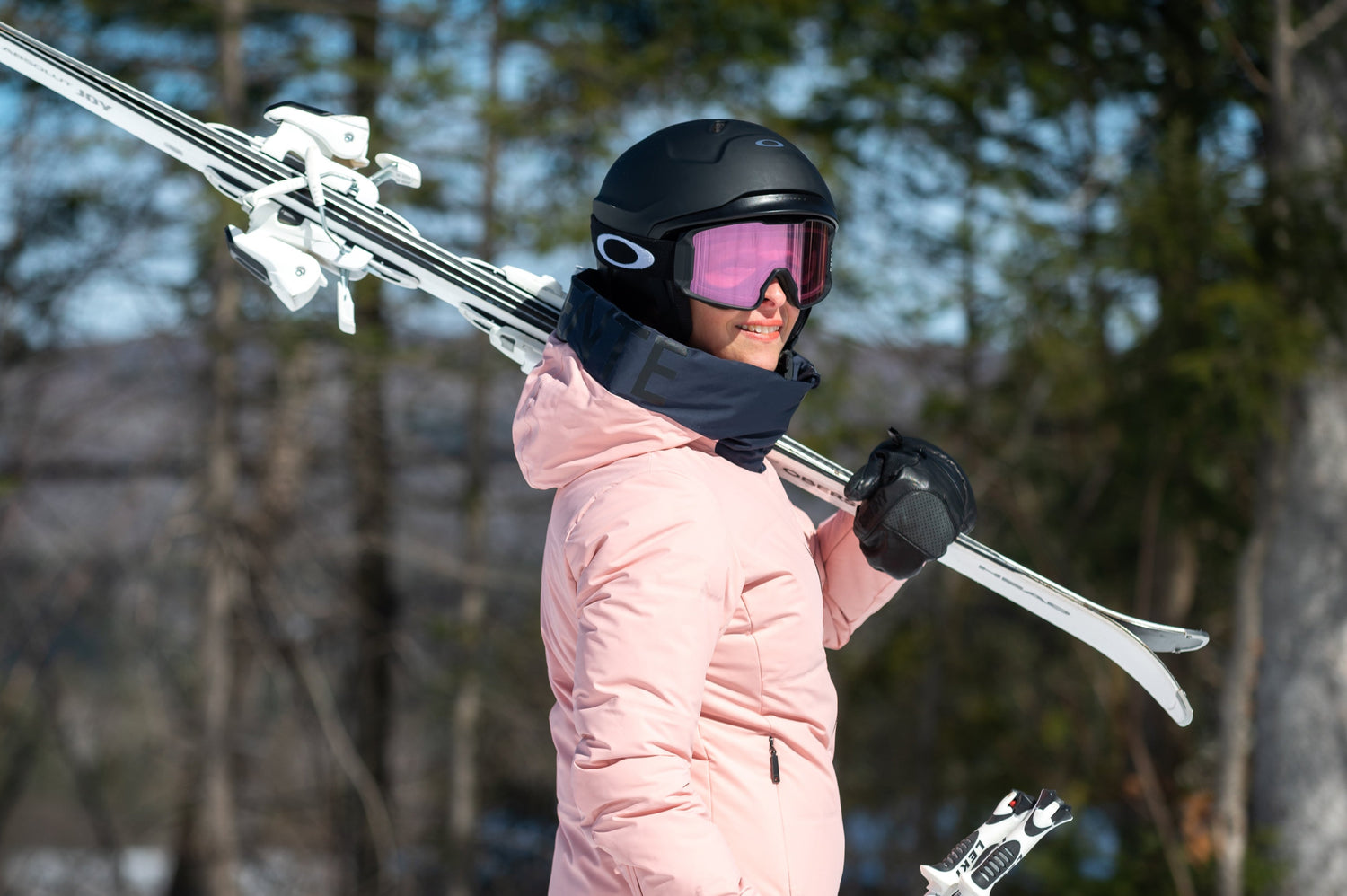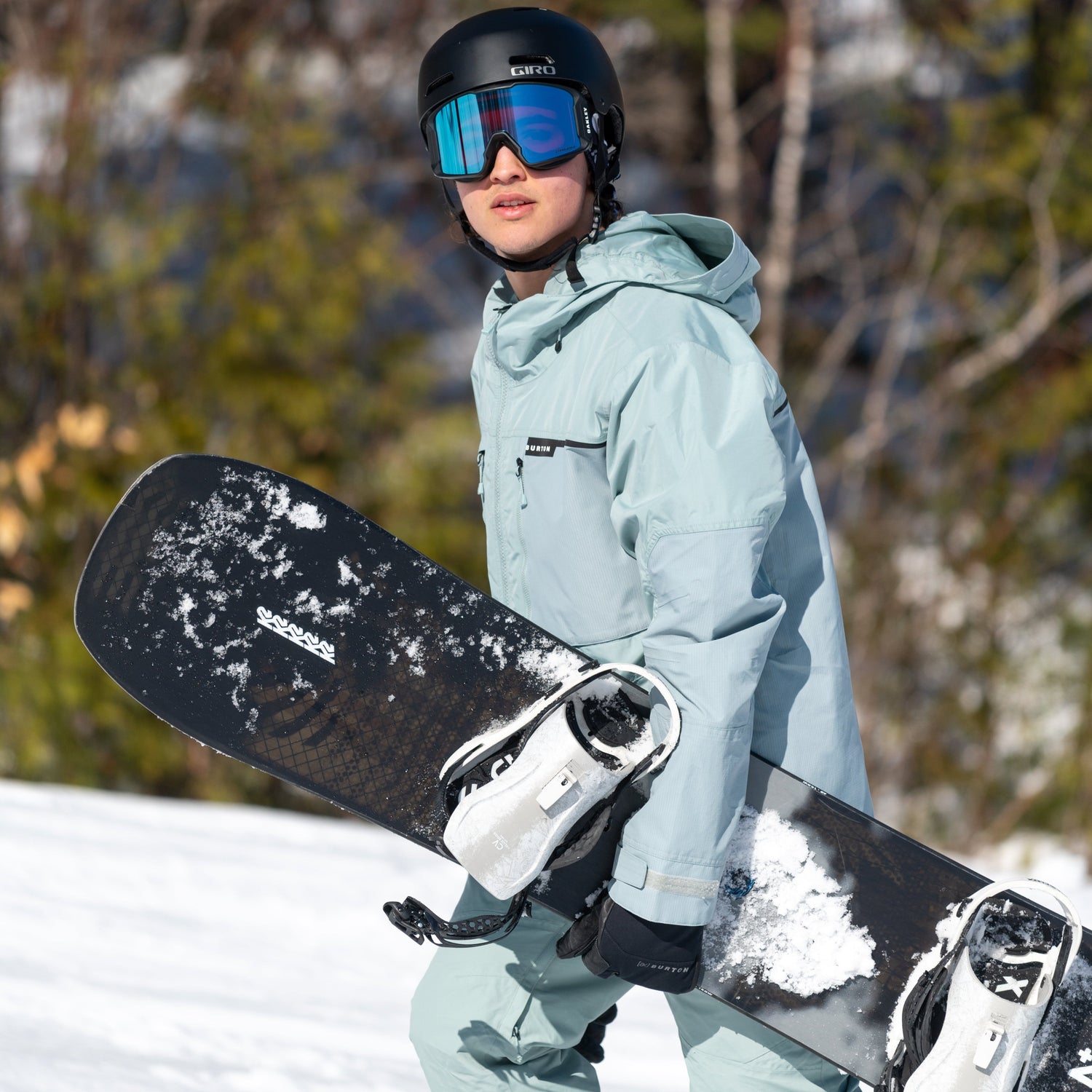To stay warm on the slopes, dress in layers so you can adapt to the weather. Start with a breathable base layer, add a mid layer if needed, and round it all out with a waterproof, breathable shell or an insulated jacket, depending on your preference. At the resort, an insulated jacket paired with a good base layer is often enough, while a full layering system works well in variable weather. Complete your ski outfit with quality gloves, a beanie, a neckwarmer, and technical socks to stay comfortable all day.
What base layer should you wear for alpine skiing?
It’s the foundation of your alpine ski clothing. The base layer’s role is to manage the moisture your body produces during activity. For this to happen, you must wear it directly against your skin, and the fit should be snug—both for the upper and lower body.
Two materials are mainly used to make base layers. The first is merino wool, and the second is synthetic fibres. A blend of the two is also possible.
Pro tip: For optimal comfort, choose a three-quarter-length base layer for your lower body. This fit prevents you from ending up with excess fabric in your ski boot liners, which can cause discomfort and pressure points.

Merino Wool Base Layer
For downhill skiing, a merino wool base layer is ideal. It provides warmth and retains its properties even when wet. Merino wool can absorb a third of its weight in moisture and leave the skin feeling dry.
- Made of 100% merino wool
- Natural, sustainable fibre
- Anti-odour
- Breathable
- Temperature regulation
- Perfect for downhill skiing or low- to medium-intensity sports.
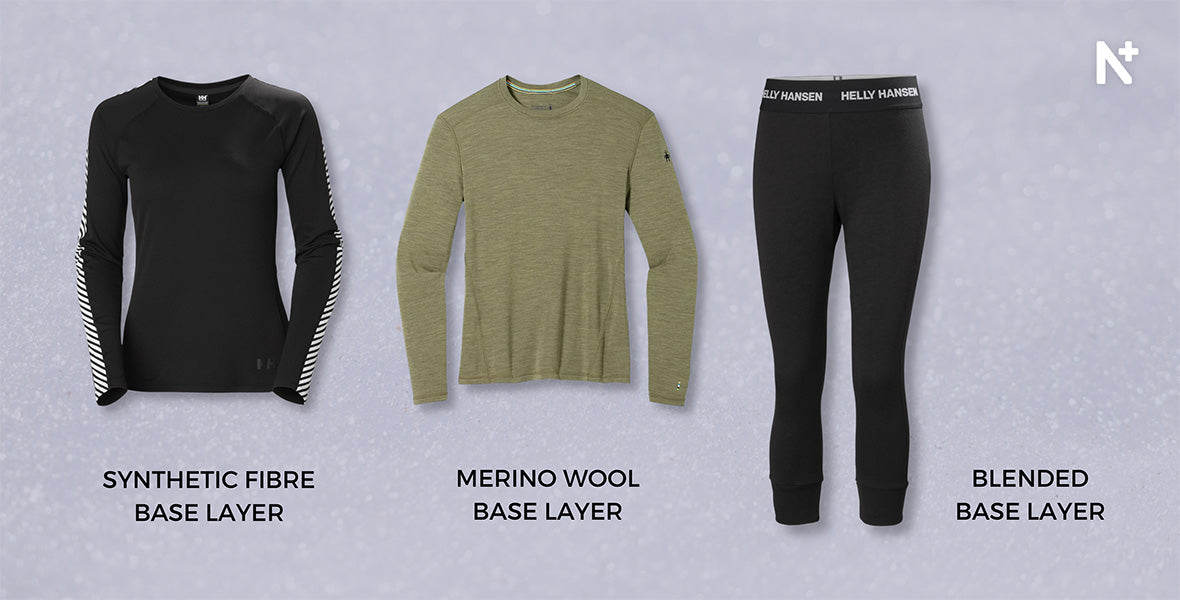
Synthetic Fibre Base Layer
Base layers made of synthetic materials are ideal for high-intensity activities or if you sweat a lot.
- Made of synthetic materials, such as polyester
- Very breathable
- Less effective odour management (but you can maintain them with Granger’s products
- Perfect for alpine touring
Blended Base Layers
Some brands also offer a blend of the two materials. Helly Hansen LIFA Merino base layers are the best example. They feature a synthetic layer directly against the skin and merino wool on the outside. These Helly Hansen base layers effectively wick moisture and retain warmth. Such base layers are extremely versatile.

What mid layer should you wear for alpine skiing?
Your body temperature can drop quickly on a chairlift. Worn over the base layer, the mid layer’s mission is to trap heat. It can be made from synthetic materials or down.
The right mid layer choice for your downhill ski clothes will be determined by the ski jacket you’ve chosen. If it’s insulated, you’ll need a light insulating mid layer, such as a fleece jacket. If you’re wearing a shell for downhill skiing, you should go with a mid layer that will act as your main insulator. Down insulating layers are outstanding options in this case.
Are you more of the type to dress in many layers? See our article Building a Multi-Layer System for Touring.
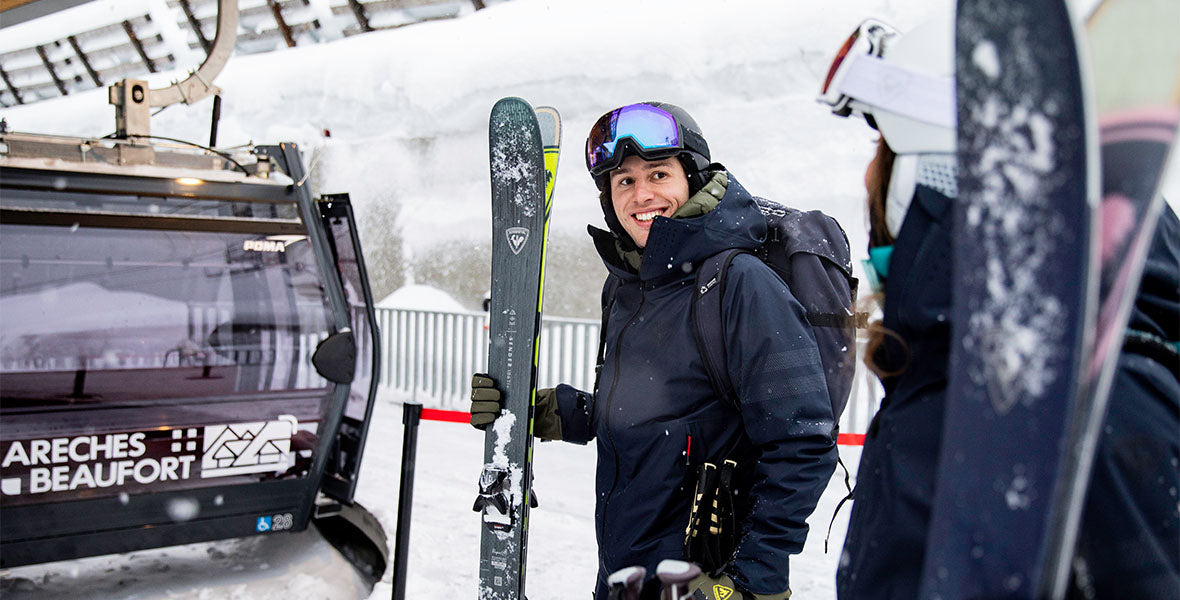
What kind of outer layer is best for alpine skiing?
Your outer layer is your ski jacket or snow pants. For skiing at a resort, insulated outer layers are ideal. The insulation, made of down or synthetic materials, provides maximum warmth during chairlift rides. Plus, the membrane is usually windproof, waterproof and breathable to protect you from the elements. You can also go with a shell jacket, but in that case, you should dress in multiple layers.
- Some Appealing Outer Layer Features
- Pockets with zippers
- Many adjustments: cuffs, hems, sizes, etc.
- Hood compatible with a ski helmet
- Pocket for a season ticket
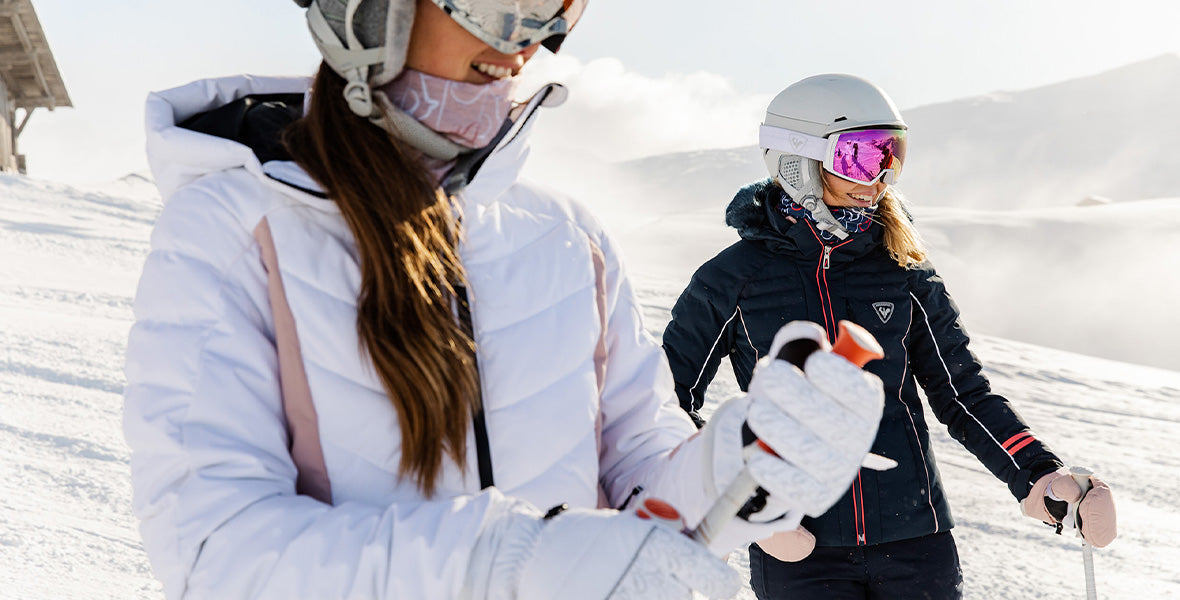
What accessories do you need for alpine skiing?
When it comes to accessories, nothing beats mittens, gloves and high-performance socks to keep your extremities warm. You can also wear a merino wool or fleece neck warmer to protect your neck. Under your ski helmet, choose a balaclava or winter cap to keep your ears warm.
Do you tend to get cold easily? Heated products—such as mittens, gloves, insoles and heated socks—are designed for you. They’re equipped with rechargeable batteries and will allow you to enjoy your time alpine skiing at the resort whatever the temperature. There are even heated garments that can be worn as a mid layer.

Ski Helmets
A helmet is essential for safe skiing. Alpine ski helmets are available in various models, colours and brands. Learn more about this equipment in our article How to Choose a Ski Helmet?.
Ski Goggles
Whether you’re bombing down sunny slopes on a bluebird day or shredding powder in the storm of the century, goggles make a huge difference in your experience. Ski goggles are designed to protect your eyes and provide a clear, accurate field of vision.
The various models and tints of ski goggles meet different needs. To understand ski goggles, read our article How to Choose Ski Goggles?.
FAQ — How to Dress for Alpine Skiing?
How do you stay warm on the chairlift?
Limit heat loss by zipping up your jacket, tightening the cuffs, and wearing a neckwarmer to block the wind. Mittens retain heat better than gloves, and a warmer mid layer can make a big difference. Heated jackets and vests are also a great option for skiers who run cold—their adjustable warmth offsets the inactivity on the chairlift and helps you stay comfortable.
How do you keep your hands and feet warm while skiing?
Keep your extremities warm by choosing thin, well-fitting ski socks. Avoid wearing two pairs or overly thick socks—both can restrict circulation and actually make your feet colder. Mittens trap more heat than gloves, and a thin liner glove can add a touch of extra insulation. On very cold days, or if you tend to get chilled, heated clothes—such as mittens, socks, or heated insoles—provide steady, adjustable warmth. They’re a game changer for many people.
How do you avoid overheating while skiing?
To avoid overheating, wear easily removable, breathable layers. Start with a moisture-wicking base layer, then adjust your warmth with a lightweight mid layer you can take off between runs. A shell jacket also works well on milder days because it’s easier to adjust ventilation. Opening the vents on your jacket and pants helps regulate your temperature without cooling you down too much.
Should you ski wearing cotton?
No. Cotton absorbs moisture—up to 27 times its weight in water when saturated—and dries very slowly, which leaves you damp and cools you off fast. To stay comfortable, choose a merino wool or synthetic base layer instead. These fabrics wick sweat more effectively and retain warmth even when you’re getting a good workout.
